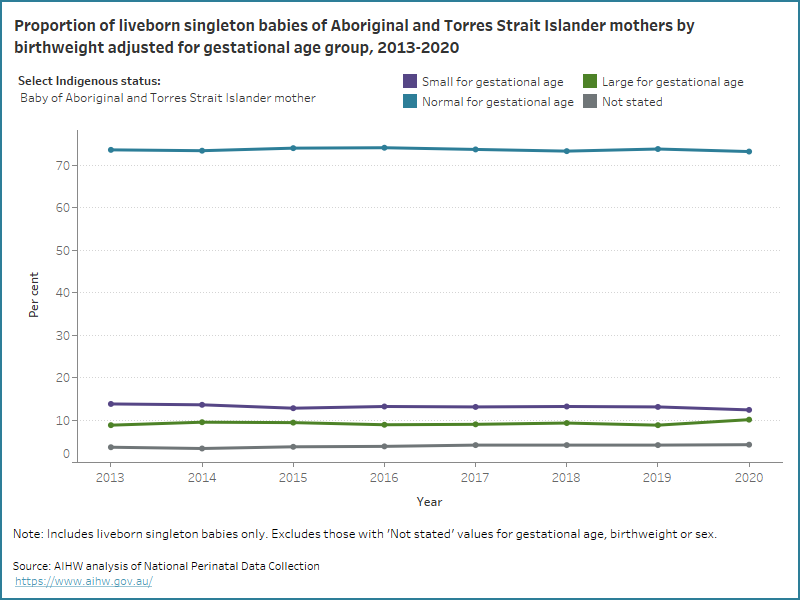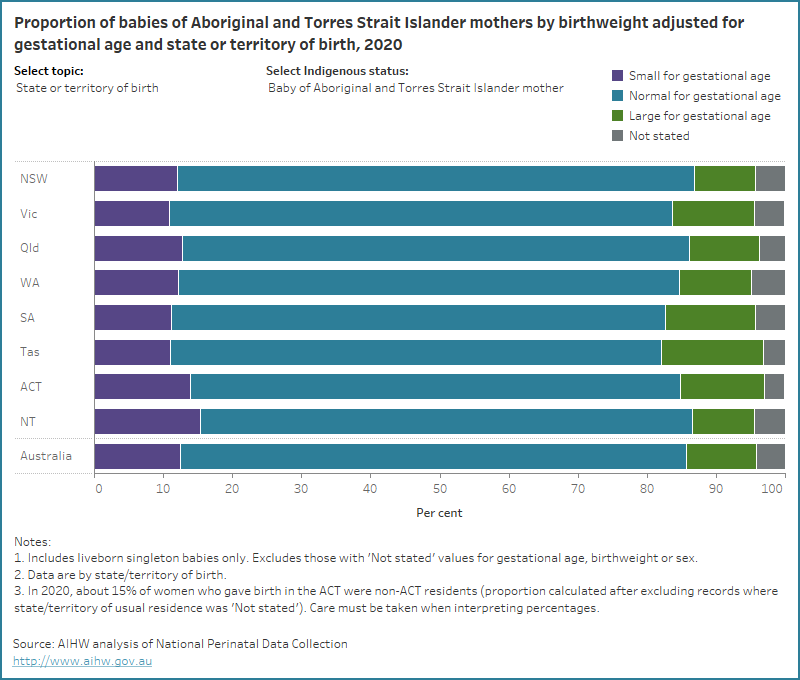 Birthweight adjusted for gestational age
Birthweight adjusted for gestational age
A baby may be small due to being born early (pre-term) or be small for gestational age, which indicates a possible growth restriction within the uterus. Poor fetal growth is associated with increased risk of stillbirth and with fetal distress during labour, and may increase the risk of to developing long-term health conditions later in life (AIHW 2022).
Adjusting birthweight for gestational age allows for differences in a baby’s growth status and maturity to be considered when examining their health at birth (AIHW 2022).
Babies are defined as being small for gestational age if their birthweight is below the 10th percentile for their gestational age and sex, and babies are defined as large for gestational age if their birthweight is above the 90th percentile for their gestational age and sex, as determined by national percentiles. Data on birthweight adjusted for gestational age is limited to liveborn singleton babies (AIHW 2022).
In 2020, 12% of babies of Aboriginal and Torres Strait Islander mothers were small for gestational age, 73% of were a normal size for gestational age and 10% were large for gestational age (compared with 8.7%, 78% and 9.3% of babies of non-Indigenous mothers).
Between 2013 and 2020, the proportion of babies of Aboriginal and Torres Strait Islander mothers who were by birthweight adjusted for gestational age group has remined largely unchanged, from 12% to 14% for small for gestational age, from 73% to 74% for normal size for gestational age and from 8.8% to 10% for large for gestational age.
The data visualisation below shows the proportion of liveborn singleton babies of Aboriginal and Torres Strait Islander mothers and non-Indigenous mothers by birthweight adjusted for gestational age group, and the proportion of liveborn singleton Aboriginal and Torres Strait Islander babies and non-Indigenous babies by birthweight adjusted for gestational age group from 2013.
Figure 1: Proportion of babies of Aboriginal and Torres Strait Islander mothers, babies of non-Indigenous mothers, Aboriginal and Torres Strait Islander babies and non-Indigenous babies, by birthweight adjusted for gestational age group from 2013 to 2020
Line graph of birthweight adjusted for gestational age by Indigenous status. Most babies of Aboriginal and Torres Strait Islander mothers were a normal size for their gestational age.

In 2020, babies who were born to Aboriginal and Torres Strait Islander mothers were more likely to be a normal size for gestational age if they were born to mothers who:
- lived in the least disadvantaged areas (75%, compared with 73% for the most disadvantaged areas)
- lived in Inner regional areas (75%, compared with 70% for Very remote areas)
- did not smoke (76%, compared with 71% of those whose mother smoked)
The data visualisation below presents data on birthweight adjusted for gestational age group for liveborn singleton babies of Aboriginal and Torres Strait Islander mothers and Aboriginal and Torres Strait Islander babies, by selected maternal and baby characteristics for 2020.
Figure 2: Proportion of liveborn singleton babies of Aboriginal and Torres Strait Islander mothers and Aboriginal and Torres Strait Islander babies by birthweight adjusted for gestational age group and selected topic for 2020
Bar chart for birthweight adjusted for gestational age by selected topics. 73% of babies of Aboriginal and Torres Strait Islander were a normal size for their gestational age.

References
AIHW (Australian Institute of Health and Welfare) (2022) Australia’s mothers and babies, Cat. no. PER 101. Canberra: AIHW.


